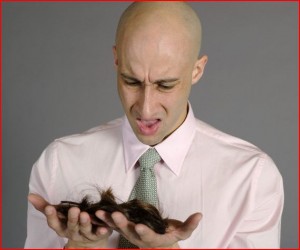Posts Tagged ‘dht’
Friday, October 21st, 2011
 Hair loss and hair thinning is a result of testosterone formed in different areas like the prostate gland or hair follicles, which is converted to Dihydrotestosterone (DHT) in the scalp area. Hair follicles prone to genetic male patterned baldness contain DHT receptors, thus thinning hair and loss of hair can result. Over time men produce an abundance of DHT and the molecules affect their hair follicles and cause a decrease in size and eventually see their natural hair fall out permanently. Because of this common occurrence, hair loss in men is frequent. Hair loss and hair thinning is a result of testosterone formed in different areas like the prostate gland or hair follicles, which is converted to Dihydrotestosterone (DHT) in the scalp area. Hair follicles prone to genetic male patterned baldness contain DHT receptors, thus thinning hair and loss of hair can result. Over time men produce an abundance of DHT and the molecules affect their hair follicles and cause a decrease in size and eventually see their natural hair fall out permanently. Because of this common occurrence, hair loss in men is frequent.
DHT and hair loss from having the gene for male pattern baldness are the most common factors for male pattern baldness. Women suffering from female-pattern baldness, unlike their counterparts with male-pattern baldness, are not usually characterized by higher production rates of DHT from lower levels of testosterone. On the other hand, if for a number of possible reasons, a woman has increased testosterone, she can develop female patterned baldness like a man does through the same mechanism.
Hair in the prone areas to male patterned baldness: Corners, top, and crown are filled with DHT receptors in men who suffer Androgenic Alopecia The hair on donor areas such as back and sides, however, have fewer DHT receptors. This is precisely why hair is more permanent on the sides and back and not the top and front.

The distinction in the hair quality of different areas, such as the donor and recipient areas, allows for hair loss surgeons to remove the hair from one area and transplant it to the bald portions of the scalp. These newly transplanted hairs are permanent and immune to DHT. Finasteride (Propecia) is a drug which blocks the conversion of testosterone to DHT as a result of it blocking the enzyme alpha reductase. The amount of DHT in hair loss patients decrease when they are on Propecia and this helps to maintain healthy hair, and also helps some of the miniaturized hair become stronger.
We at US Hair Restoration often recommend medical treatment with DHT blockers in many of our patients who undergo a hair transplantation procedure in order to help maintain their own hair in addition to the newly restored, formerly balding areas because of a hair restoration surgery.
Tags: androgenetic alopecia, dht, DHT blockers, DHT receptors, dihydrotestosterone, female patterned baldness, finasteride, hair restoration surgery, propecia, testosteron
Posted in hair loss complications, Hair Loss Conditions, hair transplant, men hair restoration, women hair loss | No Comments »
Tuesday, January 5th, 2010

The fruit Serenoa Repens produces Saw Palmetto. Saw Palmetto is an extract of it. Saw Palmetto has plenty of fatty acids and phytosterols. Considered by many to be an alternative medicine for different kinds of indications, most notably benign prostatic hyperplasia (BPH).
People who are diagnosed with benign prostatic hyperplasia (BPH) have enlarged prostates have difficulty urinating to the point that patient may need prostate surgery for it.
The part Saw Palmetto plays in hair restoration has been well researched. Incredibly, for a lot of people, Saw Palmetto is a plant-based treatment which, up to a certain point, can reverse the hair loss process or delay hair loss. Saw Palmetto’s bio active ingredients block the conversion of testosterone into dihydrotestosterone (DHT).
So, on the hair follicle level, Saw Palmetto is able to halt the process of hair loss. In addition, Saw Palmetto promotes the increased thickness of miniaturized hair, helping them grow longer. In mechanism, the Saw Palmetto effect is sort of similar to finasteride or other DHT blockers. Available in oil extract, Saw Palmetto can be used topically on hair scalps or as pills to treat prostate enlargement.
Tags: balding prevention, benign prostatis hyperplasia, BPH, dht, dihydrotestostrone, finasteride, hair loss product, hair loss treatment, male patterned baldness, saw palmetto, Saw Palmetto Extract
Posted in California hair transplant, hair loss medication, hair loss products, men hair restoration, Newport Beach hair transplant, Orange County hair transplant | No Comments »
Saturday, August 29th, 2009
 A patient sent us an email regarding his hair loss condition. He has male patterned baldness and it is still progressing. He already met with a dermatologist and had several studies done prior to the email and was even using Chronostim for approximately 3 months. Now that he’s used up the bottles of Chronostim, he has noticed no change is his hair loss situation. He wants to have a full head of hair and does not want to take hair loss medication for the rest of his life. Before we forget, his wedding is in 2 months. A patient sent us an email regarding his hair loss condition. He has male patterned baldness and it is still progressing. He already met with a dermatologist and had several studies done prior to the email and was even using Chronostim for approximately 3 months. Now that he’s used up the bottles of Chronostim, he has noticed no change is his hair loss situation. He wants to have a full head of hair and does not want to take hair loss medication for the rest of his life. Before we forget, his wedding is in 2 months.
Chronostim has not been clinically proven to correct or prevent male patterned baldness or any other form of hair loss. It should not be considered a replacement option for medications that have been both proven effective and FDA approved safe for consumption like Propecia (finasteride) DHT blocker.
We highly suggest that all patients experiencing any form of hair loss to be seen by a good hair transplant surgeon and have a miniaturization study done. If the condition is in fact male patterned baldness or androgenetic alopecia, finasteride should be a part of your everyday hair loss treatment plan.
Hair restoration surgery can restore the areas damaged by hair loss by transplanting healthy permanent hair from the donor. In this situation, however, neither of the aforementioned will make enough of a visible difference for the day of your wedding. These procedures take time to show their fullest effect. There are cosmetic options available like Toppik that can cover the balding or thinning areas of your hair through the use of microfibers. If anything, you can use that product for the wedding day while you either consider a hair transplant surgery or at least try using Propecia (finasteride) so that you may see true results a few months after your wedding.
Tags: balding prevention, chronostim, dht, finasteride, hair loss, hair loss product, hair loss treatment, hair transplant, hair transplant surgery, male patterned hairloss, men hair loss, toppik
Posted in hair loss medication, hair loss products, men hair restoration, Uncategorized | No Comments »
Friday, May 22nd, 2009
 We are getting another question on the Propecia use in men whom their wives are pregnant. A hair loss patient just asked about possible side effects that finasteride (Propecia) may cause. He has read on the manufacturer’s instructions that broken tablets must not be handled by women who are or may become pregnant. We are getting another question on the Propecia use in men whom their wives are pregnant. A hair loss patient just asked about possible side effects that finasteride (Propecia) may cause. He has read on the manufacturer’s instructions that broken tablets must not be handled by women who are or may become pregnant.
“Can finasteride cause damage to pregnant womens health or to the health of the developing fetus? Here I’d like to know also if finasteride can be found in body liquids such as men’s saliva, sweat or sperm. In such case is there any risk that a pregnant woman is exposed to finasteride? Are there any recommendations concerning taking or not Propecia before planned or during wife’s pregnancy?”
The answer to this patient’s question, which is a common question that many of young patients may ask is that finasteride (Propecia) blocks the conversion of testosterone to dihydroxytestostrone (DHT). DHT does not have any known role in adult men development, but it is crucial in development of a male fetus and child external genitalia (their penis). We at our Los Angeles, California hair transplant clinics don’t recommend taking finasteride for hair loss prevention and treatment before adulthood while maturation of external genitalia is not completed. Pregnant women should not take finasteride because of its effect on the external genitalia of their male unborn baby.
As we all know, finasteride (Propecia) is designed to block the enzyme that converts testosterone to Dihydrotestosterone (DHT). DHT does not have any real known role in an adult male but it is crucial in the developmental stage of a male fetus as well as the development of a young male’s external genitalia (penis). After reviewing the facts at our Los Angeles, California hair transplant clinics we do not recommend taking finasteride for hair loss prevention and / or treatment before adulthood while maturation of external genitalia is not completed. For this same reason, pregnant women should not take or handle finasteride because of its effects on the male external genitalia of an unborn baby.
Although the pharmaceutical company suggested that pregnant women should not be exposed to finasteride. They should not even be cutting pills that might increase the chance of inhaling small particles of finasteride. You are right about finasteride being present in body secretion such as semen and saliva. However, the amount of the medication is so small that it is considered negligible or safe for pregnant women. So the research shows that it is safe for pregnant women to be exposed to the secretions of a man whom takes finasteride. That is why we do not recommend men to stop taking finasteride if their wife becomes pregnant. There has been no evidence of any risk to a male baby from secretion of finasteride through the father’s saliva, sweat or sperm.
They even mention cutting, ingestion or inhalation of small particles of finasteride to be harmful during pregnancy. You are right to be concerned of finasteride being present in body secretion such as semen and saliva. You can find a very small trace of finasteride in body secretions but the amount of the medication is so small that it is considered negligible or safe for pregnant women. Studies show that pregnant women can be exposed to male secretion even if they are currently taking finasteride. Studies have not found any evidence of risk to a male baby from secretion with trace of finasteride through the father’s saliva, sweat or sperm. So in short we conclude that men do not need to stop using finasteride while having their wives pregnant.
Tags: dht, dihydroxytestostrone, external genitalia, fetus, Finasteride and pregnancy, hair loss, male baby, men hair loss, penis, pregnancy, semen, sperm, sweat
Posted in hair loss medication, hair loss products, men hair restoration | No Comments »
|
|
 Hair loss and hair thinning is a result of testosterone formed in different areas like the prostate gland or hair follicles, which is converted to Dihydrotestosterone (DHT) in the scalp area. Hair follicles prone to genetic male patterned baldness contain DHT receptors, thus thinning hair and loss of hair can result. Over time men produce an abundance of DHT and the molecules affect their hair follicles and cause a decrease in size and eventually see their natural hair fall out permanently. Because of this common occurrence, hair loss in men is frequent.
Hair loss and hair thinning is a result of testosterone formed in different areas like the prostate gland or hair follicles, which is converted to Dihydrotestosterone (DHT) in the scalp area. Hair follicles prone to genetic male patterned baldness contain DHT receptors, thus thinning hair and loss of hair can result. Over time men produce an abundance of DHT and the molecules affect their hair follicles and cause a decrease in size and eventually see their natural hair fall out permanently. Because of this common occurrence, hair loss in men is frequent.



